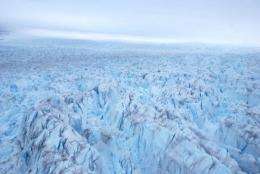Earth's climate future may be etched in Greenland bedrock

Scientists hit Greenland bedrock this week after five years of drilling through 2.5 kilometres (1.6-mile) of solid ice, a 14-nation consortium announced Wednesday.
Ice core samples from Eemian period 130,000 to 115,000 years ago -- the last time Earth's climate was a few degrees warmer than today -- could help forecast the impacts of current global warming, the researchers said.
"Our findings will increase our knowledge on the climate system and increase our ability to predict the speed and final height of sea level rise," said Dorthe Dahl-Jensen, an ice expert at the University of Copenhagen and head of the project.
"If the Eemian was unstable, then the models of future change due to increased greenhouse effect are wrong as they cannot handle sudden changes," she told AFP by email from the site.
Greenland's temperatures were 3.0 to 5.0 degrees Celsius (5.4 to 9.0 degrees Fahrenheit) higher during this last interglacial period.
Today, without steep cuts in greenhouse gas emissions, the global thermometer could rise 6.0 C compared to pre-industrial times, making large swathes of the planet unlivable, the UN's Intergovernmental Panel on Climate Change (IPCC) has warned.
Voluntary national pledges made after the Copenhagen climate summit in December would likely cap that increase at 3.5 C to 4.0 C (6.3 F to 7.2 F), still fall far short of the 2.0 C (3.6 C) limit that most scientists agree is the threshold for dangerous warming.
Over the last century, temperatures have risen by about 0.8 C.
Bedrock was struck on Tuesday at a depth of 2537.36 metres, Dahl-Jensen said.
Scientists can now gather the data they need to answer the project's core questions: How reduced was the Greenland ice sheet 120,000 years ago when global temperatures were 2.0 to 3.0 C warmer than today?
How much -- and how fast -- did it contribute to sea levels at the time?
The current status of the continent-sized ice block is sharply debated, with some scientists predicting it will remain largely stable, and other saying it could shed enough water over the coming century to raise the global water mark by a metre (39 inches) or more.
That would be enough to flood major coastal cities and send hundreds of millions of people in search of higher ground.
All told, the ice sheet stores enough liquid to lift sea levels a total of seven metres.
"When our analyses are complete, we will be able to determine to what extent the Greenland ice sheet contributed to the global sea level rise of five metres during the Eemian," Dahl-Jensen said.
She added that the first results should be published before the end of this year.
Previous deep ice cores from Greenland have yielded only partial data from this critical period analogous to our own, either because some layers have melted or been disturbed by ice flow close to the bedrock.
Techniques used to study ancient climate change include examining variations in oxygen atoms, called isotopes, that correspond to different atmospheric temperatures, and analysing greenhouse gas bubbles trapped in the ice.
The crystal structure of ice, the temperature of the bore hole, and the content of biological material found also provide data about past climate conditions.
The 14 countries participating in the project are Belgium, Canada, China, Denmark, France, Germany, Iceland, Japan, South Korea, The Netherlands, Sweden, Switzerland, United Kingdom and the United States.
(c) 2010 AFP





















